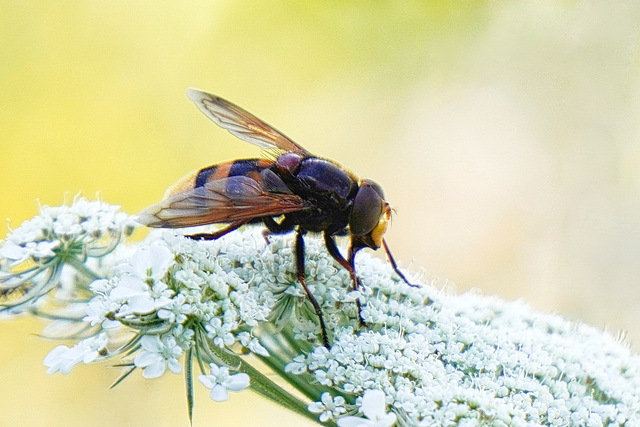Mit Igelfrisur - With hedgehog hairstyle
Zeit der Sonnenhüte - Time of the coneflowers
Bei der Balz - During mating
Was guckst du? What are you watching?
Warten auf Beute - Waiting for prey
Sooo lange Fühler - So long antennae
Perfekte Symmetrie - Perfect symmetry
Paarungsbereit - Ready to mate
Biene oder Wespe? Bee or wasp?
Eine dicke Hummel ... A big bumblebee ...
Der zweitkleinste Bläuling Mitteleuropas - The sec…
Verführerisch, aber sehr giftig - Seductive, but v…
Einen der größten Laufkäfer Mitteleuropas ... One…
Fressen und gefressen werden - Eating and being ea…
Isodontia mexicana - Extreme Wespentaille - Extrem…
Die Komplexaugen der Insekten - The compound eyes…
Mit fünf Augen sieht man besser - You see better w…
Friedliche Koexistenz - Peaceful coexistence
Der Kolibrifalter aus dem Süden - The Hummingbird…
Ein Russischer Bär - A Jersey tiger - PiPs
Auch ohne Zipfel kann man leben ... You can live e…
Die Ernte ist eingebracht - The harvest is in
Ein Kloster der "Gärtner Gottes" - A monastery of…
Nur für Hummeln und Schmetterlinge geeignet ... On…
Ein scheuer Waldbewohner - A shy woodland dweller
Ein ganz seltener Gast - A very rare guest - 2PiP
Insekten-Kamasutra (2)__Insect Camasutra (2) - PiP
Insekten-Kamasutra (1)__Insect Camasutra (1)
Mein Überraschungsfund - My surprise find
Der typische Schmetterling im Hochsommer - The typ…
Die Blumenkönigin des Waldes - The flower queen of…
Ein Liebhaber warmer Standorte ... A lover of warm…
Mit einem ganz langen Saugrüssel ... Equipped with…
Eine haarige Schönheit - A hairy beauty
So eine Hitze ... Such a heat ...
Wie aus grauer Vorzeit ... Like from ancient times…
Seid fruchtbar und mehret euch ... Be fruitful and…
Sommerbeginn - Start of summer
Ein Sexualprotz - A sex maniac - PiP
Eine zarte Schmetterlingsfee - A delicate butterfl…
Fortpflanzung bei Azurjungfern - PiPs and note
Eine feine Sommerfrische ... A fine summer retreat…
Der Musenberg im Großen See - The muses mountain i…
Eine schöne Trutzburg - A beautiful fortress
An der ewigen Liebe nagt der Zahn der Zeit ... The…
See also...
Keywords
Authorizations, license
-
Visible by: Everyone -
All rights reserved
-
186 visits
Keine Angst vor dieser "Hornisse" - Do not be afraid of this "hornet" - PiP


Es ist doch nur die Hornissenschwebfliege (Volucella zonaria)! Sie ist die größte mitteleuropäische Schwebfliege und ähnelt sehr stark einer Hornisse. Sie wird manchmal bis 22 mm groß und ist völlig harmlos. Zur Fortpflanzung dringen die Weibchen in ein Nest von Hummeln, Wespen oder Hornissen ein und legen dort ihre Eier ab. Die Larven ernähren sich vom Abfall im Nest und verpuppen sich außerhalb des Nests im Erdreich.
Die Hornissenschwebfliege ist relativ selten, ihr Bestand wird aber als ungefährdet eingestuft.
Im Bild eine Hornissenschwebfliege auf der Blüte einer Wilden Möhre (Daucus carota), wo sie sich vom Pollen und Nektar ernährt. Im PiP eine Abbildung von hinten.
de.wikipedia.org/wiki/Hornissenschwebfliege
It's just the hornet mimic hoverfly (Volucella zonaria)! It is the largest Central European hoverfly and resembles very much a hornet. It sometimes grows to 22 mm in size and is completely harmless. To reproduce, females enter a nest of bumblebees, wasps or hornets and lay their eggs there. The larvae feed on the waste in the nest and pupate outside the nest in the soil.
The hornet hoverfly is relatively rare, but its population is classified as non-endangered.
The photo shows a hornet hoverfly on the flower of a wild carrot (Daucus carota), where it feeds on pollen and nectar. In the PiP an photo from behind.
Translate into English
Die Hornissenschwebfliege ist relativ selten, ihr Bestand wird aber als ungefährdet eingestuft.
Im Bild eine Hornissenschwebfliege auf der Blüte einer Wilden Möhre (Daucus carota), wo sie sich vom Pollen und Nektar ernährt. Im PiP eine Abbildung von hinten.
de.wikipedia.org/wiki/Hornissenschwebfliege
It's just the hornet mimic hoverfly (Volucella zonaria)! It is the largest Central European hoverfly and resembles very much a hornet. It sometimes grows to 22 mm in size and is completely harmless. To reproduce, females enter a nest of bumblebees, wasps or hornets and lay their eggs there. The larvae feed on the waste in the nest and pupate outside the nest in the soil.
The hornet hoverfly is relatively rare, but its population is classified as non-endangered.
The photo shows a hornet hoverfly on the flower of a wild carrot (Daucus carota), where it feeds on pollen and nectar. In the PiP an photo from behind.
bonsai59, ColRam, Nora Caracci, Marco F. Delminho and 35 other people have particularly liked this photo
- Keyboard shortcuts:
Jump to top
RSS feed- Latest comments - Subscribe to the comment feeds of this photo
- ipernity © 2007-2024
- Help & Contact
|
Club news
|
About ipernity
|
History |
ipernity Club & Prices |
Guide of good conduct
Donate | Group guidelines | Privacy policy | Terms of use | Statutes | In memoria -
Facebook
Twitter

Wünsche noch einen schönen Nachmittag,ganz liebe Grüße Güni :))
cammino club has replied to ©UdoSm clubAdmired in: www.ipernity.com/group/tolerance
Sign-in to write a comment.